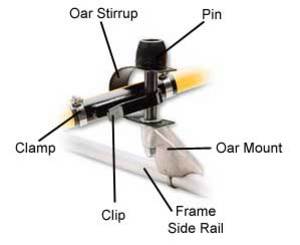There has long been a debate in the whitewater-rafting world as to which is a better rowing setup: pins and clips or oarlocks. Both accomplish the basic function of getting you down the river in one piece. However, there are distinct and important differences between the two.
If you’re unfamiliar with the two setups the main difference is in the pins and clips. As the name states the raft oars are fitted with clips, which fit into pins on the raft frame. When they’re clipped in they’re secured so you aren’t able to rotate the oar or slide them within the clip. In affect, they are secured to the raft frame; the pins acting as a hinge point for the rowing motion.
The advantage this gives the rower is the peace of mind that your oars are always in the correct position for rowing. The blade angle is correct, the distance to the water is correct, and you won’t easily lose an oar because it popped out of the oarlock. The pins and clips secure the oar so you won’t lose it unless it breaks.
The standard rafting oarlock is shaped like a U, the oar fits into the U and acts as the hinge point for rowing. Since it is an open shape the raft oar can rotate, and be slid back and forth within the oarlock.
Ironically the disadvantages are also the advantages to this raft rowing setup. It is up to the oarsperson to have the proper angle on the oar, and the proper distance to the water. There are no training wheels with the standard oarlock setup. People that use this system have more options in their rowing repertoire. They can feather, or rotate the oar after each stroke to cut through wind, they can pull the oar into the boat to avoid obstacles or just rest the oar out of the water, and they can quickly replace a broken oar with a new one.
The real disadvantage is the chance of losing an oar because it pops out of the oarlock. However, because the U shape is skinnier at the opening than the oar is wide, this is a fairly rare occurrence.
It’s definitely easier to progress from rowing with pins and clips to the standard oarlock setup than the other way around. Going from the standard to the pins and clips can feel like you’re strapping handcuffs on your wrists. The freedom of movement with the standard to the restricted movement of the pins and clips will feel terrible and is hard to get used to.
Both setups are acceptable. It really comes down to which method you prefer. People that start rowing with pins and clips usually stick with them their whole rowing career. The same holds true for the standard oarlocks. If you have used both equally you’ll probably have more of a propensity for the standard oarlock because of its versatility.
